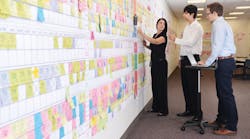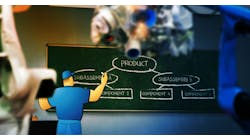When It Comes to Product Development, There's No Time to Lose
In his new book, Lean-Driven Innovation: Powering Product Development at The Goodyear Tire & Rubber Co., Norbert Majerus presents a brief history of product development at the global tire company. It includes this passage:
"In Goodyear R&D, we had no criteria for accepting new work. A project could start as a result of a meeting with marketing, a request for new raw material approval by a supplier, or a function deciding to develop new technology. Virtually everything was accepted and a project began. It was culturally unacceptable to say "No" to a request from another function, a customer, or a stakeholder. We always had a lot more projects than the capacity to complete them."
The outcome of this process seems fairly foreseeable. Unpredictable product launches, frustrated engineers, missed revenue opportunities.
"It was accepted that products got launched when development eventually finished the project, not when the market needed those products," says Majerus, an R&D engineer and 37-year veteran of the company.
In short, Goodyear has become quicker and more agile -- and better able to react to changing market and customer demands. It's a story in which speed as a competitive advantage is more than a catchy phrase, it's a promise.
It's not Goodyear's story alone, of course. While many companies still struggle with speed, others are riding it to bigger gains. What differs is their means of gaining the time advantage.
The Google Approach
Google gives plenty of thought to time. The technology company's policy of encouraging some of its people to use 20% of their time to brainstorm new ideas has been widely written about. That said, Google also recognizes the peril of the passage of time when it comes to innovation. Speedy forward momentum is the order of the day -- especially when it comes to failure.
"Fail first, fail early, fail quick. Celebrate the failure, learn from the failure. Reiterate. Reiterate. Reiterate. The product gets faster; it gets better." That's among the advice offered by Michael Walton, head of manufacturing at Google for Work, during his keynote address at the 2015 Association for Manufacturing Excellence conference. Walton was at the Cincinnati event to share Google's recipe for innovation, and words like "speed" and "fast" frequently peppered his discussion.
He also provided a description of what innovation is not, although it may ring familiar with some manufacturers: You make stuff. You measure it 90 times and want management to see you measuring it 95 times. Then you do what you can to "cover your rear" to avoid blame when a product is released.
"That's not innovation," declared Walton after outlining the scenario. "That's incremental innovation that doesn't always grab market share, and I guarantee you that in this world, in this age, your product will be copied at a third of the time and cost that you spent doing it. So fail first, fail early."
It's hard not to argue that Google -- and now its holding company Alphabet -- knows something about innovation. The wildly successful company is less than two decades old (It doesn't turn 20 until 2018), yet the Google search engine is the undisputed leader and Google's Android operating system dominates the smartphone space.
And don't forget Google Glass. Announced in 2012 and available on a limited basis by early 2013, the technology has not proven as popular as Google had to have hoped -- although it has found a home in some manufacturing companies, which have employed its capabilities for tasks including hands-free scanning, assembly processes and quality control.
The lack of widespread adoption appears only to have prompted Google to try harder.
"We thought it was the coolest product in the world and we're breaking the mold on it again," Walton said. "We're saying that's not enough, because of you. You said it's not enough."
So how did Google get to a place where failure is cherished as a learning opportunity, just don't drag it out -- fail fast? It's all about culture, says Walton, who shared nine Google guiding principles for innovation. They are:
1. 10X. In other words, forget about a 10% improvement. Improve by a factor of 10.
2. Launch and keep listening.
3. Share all you can/collaboration
4. Hire the right people.
5. Use the 70/20/10 rule.
6. Employee empowerment. Look for ideas everywhere.
7. Use data, not opinions.
8. Focus on the user, not competition.
9. Cherish victories and failures
(do not condemn them).
At Google, analysis of a failure does not translate to analyzing "where you went wrong." Instead, says Walton, the discussion revolves around what happened -- what worked and what didn't -- as well as how to improve in the next iteration. "That's a lot easier to do when you're not invested for six months," he acknowledges.
Does such an environment seem impossible in your circumstances? Give it a try, urges Walton. "Create an environment that learns from failure. Just do it. If you're not convinced, run a little team, reiterate, give them a month, give them a week, see what happens. [There's] no harm in that."
Goodyear's Lean Approach
And now, back to Goodyear, which about a decade ago decided to pursue a lean approach in its effort to speed up the development of new products.
One of the world's largest tire companies, Goodyear employs a workforce of approximately 66,000 people. It makes product in 49 facilities across 22 countries, and has several innovation centers including one at its headquarters location in Akron, Ohio.
You can add another number to the list just cited: 1,500. That is the approximate number of new SKUs (stock keeping units) the tire maker launches each year. And despite the large quantity of launches, "almost 100% of those come out on time, on schedule, on target, and have been for at least seven years now," says Goodyear's Majerus.
Nearly 100% on time was not the case 10 years ago. While Goodyear's product quality hadn't been an issue (in fact, the company had recently won a J.D. Power award), its ability to get products to market on time was. When new management joined the company in 2005, "they were less willing to accept the fact that sometimes our products were late, and we were not fast enough in bringing products to the market," explains Majerus. "We realized we could not continue working like that because there's way too much money that the company isn't able to make in the market if you don't have the product."
— Norbert Majerus
Majerus became the company's lean champion. "The idea was let's see if we can use traditional lean thinking around value. A lot of people seem to think lean is about reducing costs. We were convinced lean is about creating more value for the customer and better outcomes for the company. That's what we looked at," Majerus says. "We realized the biggest value we could create as a development organization was to be able to deliver everything on time. Even if the conditions in the market changed, we needed to be agile enough to hit that new date."
In Lean-Driven Innovation, Majerus details the company's journey to radically improve its product-development process. He shared several key learnings with IndustryWeek.
- The company used outside assistance to teach it the principles of lean, but not to tell Goodyear what to do to improve. "The transformation itself was all from the inside out with our own people learning the principles, applying them, changing the way we did work," Majerus says.
- Goodyear has embraced concurrent product development. Once upon a time, the lean champion explained, R&D would develop a product, pass it to manufacturing, which then would come back to R&D a few months later and say it didn't work and needed changing.
- "Then we redesigned it, and then we gave it to them again, and then they came back again…" and the cycle repeated, Majerus said. "We don't work that way anymore. We sit down on day one of the new project -- everybody, every stakeholder involved, marketing, manufacturing, supply chain, everybody -- and we lay it on the table. Everybody participates on this project at the same time."
- They start as late as possible, while still assuring on-time delivery targets will be met. "We used to think the earlier we got started on something, the earlier we would finish it," Majerus says. That turned out not to be true. What the company learned instead was "the later you start something, the more you know about it and the [fewer] changes there will be. So we found that is a way to save quite some time on projects."
- Where engineers once worked on multiple projects simultaneously, today they work on one project at a time. While it may seem counterintuitive, the change has made the engineers faster. Majerus said they now perform nearly three times as many learning cycles -- or iterations -- as they did before the lean implementation.
How do you know when a lean-driven innovation process is heading toward success? In Goodyear's case, Majerus points to a meeting that occurred among the market leaders, about two years into the lean initiative. During that meeting, the marketing vice president said, "I don't know how you did this, but we all of a sudden seem to get everything we need, and that never happened before." He added, "I noticed it in the [financial] numbers."
For all the talk of speed, successful implementation of a lean product development process is not something that happens in a few days. "We took a few steps backwards, but in general there was enough movement forward that nobody really got discouraged," Majerus says.
Moreover, he adds, "We had great support from top management and that was a major part of getting everyone aligned."







